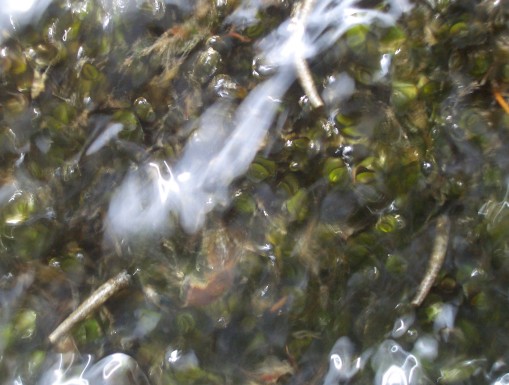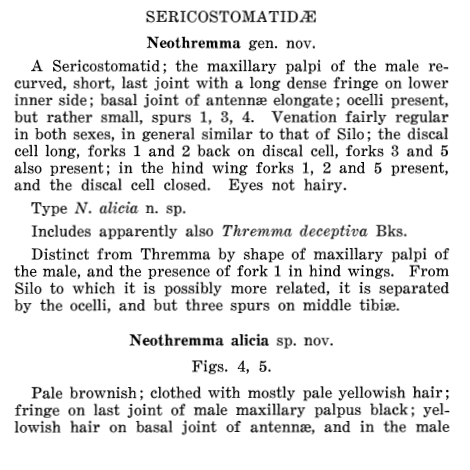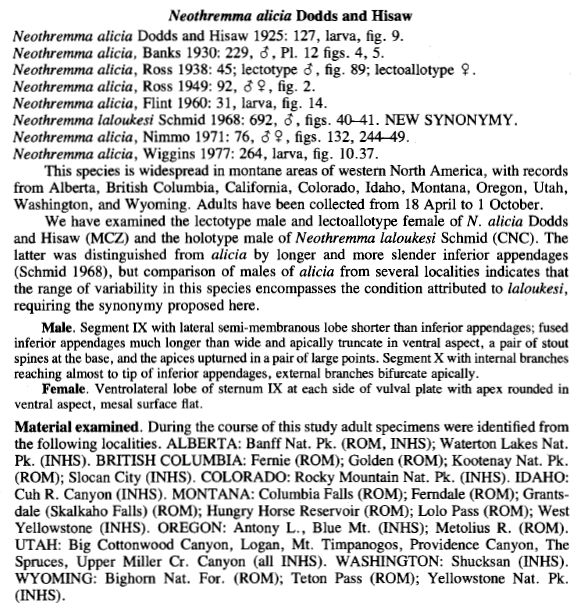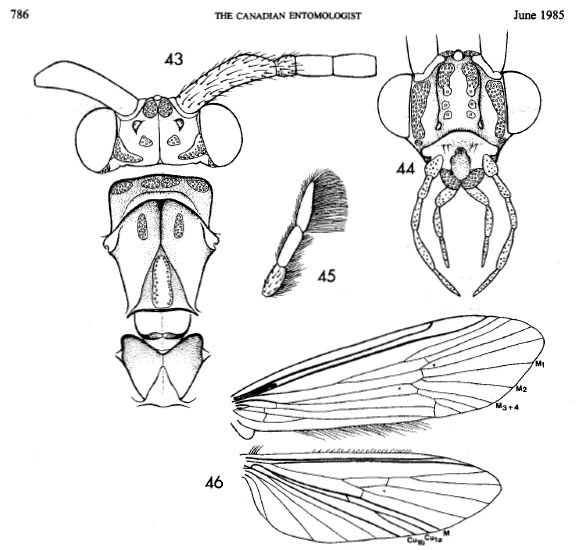Trichoptera: Uenoidae of Gunnison County, ColoradoNeothremma aliciaDodds and Hishaw 1925Updated 20 Dec 2020
TSN 116389 
The three animals on the right were clinging to the moss in a small subalpine stream on 18 July 2007. Good LinksOn this website:Ueonidae Introduction Other Websites: Photos, Map, Museum specimens, DNA - Barcodinglife.org Illustration - University of Alberta Entomology Collection Species page Has description, habitat information, range and more. Locations CollectedFound in large numbers in small mossy streams in the headwaters of the East River. Allan (1975) reports this species from Cement Creek.
ReferencesAllan,JD 1975 The distributional ecology and diversity of benthic insects in Cement Creek, Colorado. Ecology 56:1040-1053. PDFÀlvarez,M and Peckarsky,BL 2014 Cascading effects of predatory fish on the composition of benthic algae in high-altitude streams. Oikos, 123(1)120-128. PDF Banks,N 1930 New neuropteroid insects from the United States. Psyche 37: 223-233. Nathan Banks describes the new genus Neothremma as part of the caddisfly family Sericostomatidae and designates Neothremma alicia as the type species. This species has since been moved to the family Limnephilidae and then to the family Ueonidae (Wiggins et al, 1985) He includes an illustration of the male head and genitalia. 



Djernæs,M and Sperling,FAH 2012 Exploring a key synapomorphy: correlations between structure and function in the sternum V glands of Trichoptera and Lepidoptera (Insecta). Biological Journal of the Linnean Society, 106: 561-579. Dodds,GS and Hisaw,FL. 1925 Ecological studies on aquatic insects. III. Adaptations of caddisfly larvae to swift streams. Ecology 6(2)123-137. Abstract and first page 


 Flint,OS, Jr. 1960 Taxonomy and biology of Nearctic limnephilid larvae (Trichoptera), with special reference to species in eastern United States. Entomologica Americana 40:1-117. Describes the larvae. Gaufin,AR; Clubb,R and Newell,R 1974 Studies on the tolerance of aquatic insects to low oxygen concentrations. Great Basin Naturalist 34:45-59. PDF The authors studied the acute short term tolerance of aquatic insects to low oxygen. They used the 96 hour Median Tolerance Limit. The TLm96 for N. alicia was 1.7 mg/l and 14% oxygen saturation. This was the least tolerance for low oxygen of the 7 species of caddisflies they studied. Gaufin,AR and Hern,S 1971 Laboratory studies on tolerance of aquatic insects to heated waters. Journal of the Kansas Entomological Society 44:240-245. PDF Abstract: "The mature larvae of fifteen species of aquatic insects (Diptera, Ephemeroptera, Plecoptera, and Trichoptera) and the scud (Amphipoda) were tested to determine their relative sensitivity to heated waters under laboratory conditions. The temperature at which 50% died after 96 hours (TLm96) was recorded as the lethal temperature. This ranged from 11.7 C for the torrential stream mayfly, Cinygmula par Baton, to 32.6 C for the snipefly, Atherix variegata Walker. " They found the TLm96 for N. alicia was 25.9°C. Herbst,DB and Silldorff,EL 2009 Development of a benthic macroinvertebrate index of biological integrity (IBI) for stream assessments in the Eastern Sierra Nevada of California. Reporte Final. California Environmental Protection Agency. Los Angeles, EUA. PDF The authors assign a tolerance value of 0 to the genera Neothremma. The scale is from 0-10, with zero being intolerant and 10 being the most tolerant of the genera they studied in detail. Herrmann,SJ; Ruiter,DE and Unzicker,JD 1986 Distribution and records of Colorado Trichoptera. Southwestern Naturalist 31 4, 421-457. Notes that Neothremma alicia lives in Gunnison County. Quote from page 452: "Habitat: streams, seeps; Altitudinal range: 2536-3170m; Adult collection dates; 24 July to 25 August; The two western nearctic genera Neothremma and Farula were removed from the family Limnephilidae and assigned to the family Ueonidae (Wiggins et al, In press) " Jiang,X 2010 Gene Flow and Dispersal of the Caddisfly, Neothremma alicia, in the Rocky Mountains of Utah: A Multiscale Analysis. PDF Abstract: "We determined genetic variance and gene flow across multiple scales (reaches, tributaries, and catchments) to examine the dispersal ability of the caddisfly, Neothremma alicia in streams along the Wasatch Range in the Rocky Mountains of Utah. Neothremma alicia is one of the most abundant caddisflies in this region. We generated DNA sequence data (mitochondrial COI) from 34 reaches, nested in 15 tributaries distributed across 3 adjacent catchments. We identified 47 haplotypes from a total of 486 individuals. The most abundant haplotype (H1) was found at all sites/reaches and comprised 44% of the total number of individuals sequenced. The remaining rare haplotypes (46) were recently derived from the dominant, H1 haplotype. All of the rare haplotypes were restricted to a single catchment with 81 % restricted to either a single tributary or to two adjacent tributaries. We found the largest FST values among tributaries and the smallest FST values between reaches within tributaries suggesting that dispersal and gene flow is largely confined to within tributaries. This result supports the observation that aerial adults commonly crawl and fly along the stream corridor, especially in deeply incised valleys of mountainous regions. Our analyses show that this population has experienced a bottleneck that may have reduced population genetic variance from many haplotypes to one single dominant haplotype, H1. The rare haplotypes may have diverged since the bottleneck from the H1 haplotype and thus, have not had time to disperse outside their catchment and in most cases outside their specific tributary. Our analyses indicated that the bottleneck took place between 1,000 and 10,000 years ago. Thus, it appears that most rare haplotypes have been unable to colonize outside of the tributary they originated in for around 1,000 years." Mecom, John O. 1972 Productivity and distribution of Trichoptera larvae in a Colorado mountain stream. Hydrobiologia 40(2): 151 - 176. ISSN: 0018-8158 (Paper) 1573-5117 (Online) DOI: 10.1007/BF00016789 Abstract Has life history data from the St Vrain River in Colorado. Nimmo, A 1971 The adult Rhyacophilidae and Limnephilidae (Trichoptera) of Alberta and eastern British Columbia and their post glacial origin. Quaestiones Entomologicae 73: 3-234. Ogilvie,GA and Clifford,HF 1986 Life histories, production, and microdistribution of two caddisflies (Trichoptera) in a Rocky Mountain Stream. Canadian Journal of Zoology 64(12)2706-2716. Abstract: "This paper reports results of a 2-year study of the caddisflies Oligophlebodes zelti (Limnephilidae) and Neothremma alicia (Uenoidae) in a first-order Rocky Mountain stream of southern Alberta. The Oligophlebodes population had a univoltine cycle: eggs were oviposited in July and August and hatched in about 20 days, and the larvae grew rapidly during the remainder of the ice-free season. Larvae overwintered in the fourth larval instar and molted to the fifth instar the following spring. Pupation occurred in June, and adults started emerging in mid-July. Annual production for the O. zelti population was 116 mg·m-2·year-1. The Neothremma population had a 2-year cycle. Eggs apparently hatched after freeze-up. Larvae overwintered in the second instar. Most of the population achieved the third instar by the following July and the fourth instar by August, and spent the second winter in either the fourth or fifth instar. There was about a 3-week prepupal stage the following July and then emergence in July and August. Annual production for the N. alicia population was 103 mg·m-2·year-1. Oligophlebodes zelti and N. alicia larvae fed mainly on fine particulate organic matter and diatoms. Both O. zelti and N. alicia larvae were found on rocks only in fast water areas, but the two populations did not inhabit the same riffles. The riffles inhabited by O. zelti were wider with lower slopes and water velocities than riffles dominated by N. alicia larvae. Correlation analysis, using several parameters, indicated that total periphyton of the rocks might be a major factor accounting for O. zelti's distribution. The microdistribution of the N. alicia population was not correlated with any food source." Rader,R and Belish, TA 1999 Influence of mild to severe flow alterations on invertebrates in three mountain streams. Regulated Rivers: Research & Management. 15(4)353 - 363. They comment that Neothremma alicia " declined or were even locally extirpated" by severe flow alterations due to dams and water abstraction of their habitat. Rader, R.B., Unmack, P.J., Christensen, W.F. and Jiang, X., 2019 Connectivity of two species with contrasting dispersal abilities: a test of the isolated tributary hypothesis. Freshwater Science, 38(1), pp.142-155. PDF Abstract: "The isolated tributary hypothesis (ITH) states that headwater tributaries are insular habitats, and therefore, populations in tributaries will have low genetic connectivity. We compared genetic differentiation in a species that should have high genetic connectivity (the caddisfly, Neothremma alicia) with a species previously shown to have poorly connected populations (the flatworm, Polycelis coronata). These species should represent the range of dispersal abilities for stream invertebrates in our system, so similarly high levels of genetic differentiation among tributary populations in both species would support the ITH. We collected N. alicia from 34 stream sites, nested in 15 tributaries, and P. coronata from 50 sites, nested in 26 tributaries. Both species co-occurred in 76 of the sites from the same 4 catchments in the central Wasatch Mountains of Utah, USA. The straight-line distance between sites for N. alicia ranged from 0.5 km to 52 km, with an average of 22 km, whereas the straight-line distance between sites for P. coronata ranged from 0.5 km to 66 km, with an average of 25 km. We identified 47 haplotypes from 486 individuals of N. alicia with a 796-bp unit of mtDNA sequence data (the mitochondrial cytochrome oxidase I gene [COI]) and 130 haplotypes from 468 individuals of P. coronata with a 763-bp unit from the COI gene. All haplotypes but the dominant one of N. alicia were restricted to a single catchment, and 59.6% of N. alicia haplotypes were restricted to a single tributary. Tributaries were the only level of the stream hierarchy to show significant differentiation between N. alicia populations. In contrast, 77% of the P. coronata haplotypes occurred in a single site, and there was little gene flow either between sites in the same tributary or between tributaries. These results support the ITH because most haplotypes of both species were confined to either tributaries or sites within tributaries. Furthermore, evidence of a bottleneck event suggests that most haplotypes of N. alicia have been unable to move between tributaries for hundreds to thousands of generations. If rates of anthropogenic disturbances are high (e.g., climate warming), then the rate of population decline could exceed the rate of recolonization, increasing extinction risk for invertebrates in streams of the central Wasatch Mountains regardless of their relative dispersal abilities." Ross, H. H. 1949. The caddisfly genus Neothremma Banks (Trichoptera: Limnephilidae). Journal of the Washington Academy of SciencTronstad,LM; Hotaling,S; Giersch,JJ; Wilmot,OJ and Finn,DS 2020 Headwaters fed by subterranean ice: potential climate refugia for mountain stream communities?. BioRxiv, p.788273. es 39:92-93. Tronstad,LM; Hotaling,S; Giersch,JJ; Wilmot,OJ and Finn,DS 2020 Headwaters fed by subterranean ice: potential climate refugia for mountain stream communities?. BioRxiv, p.788273. Abstract: "Near-term extirpations of macroinvertebrates are predicted for mountain streams worldwide as a warming climate drives the recession of high-elevation ice and snow. However, hydrological sources likely vary in their resistance to climate change and thus streams fed by more resistant sources could persist as climate refugia for imperiled biota. In 2015-2016, we measured habitat characteristics and quantified macroinvertebrate community structure along six alpine streams in the Teton Range, Wyoming, USA. Strong differences in habitat characteristics (e.g., temperature, bed stability, conductivity) confirmed three major stream sources: surface glaciers, perennial snowfields, and subterranean ice. Subterranean ice-fed streams - termed "icy seeps" - appear common in the Teton Range and elsewhere yet are globally understudied. Midges in the family Chironomidae dominated our study sites, representing 78.6% of all specimens sampled, with nematodes, caddisflies (Neothremma), and mayflies (Epeorus) also common. At the community-scale, glacier-and snowmelt-fed streams differed significantly in multivariate space, with icy-seep communities intermediate between them, incorporating components of both assemblages. Because the thermal environment of subterranean ice, including rock glaciers, is decoupled from large-scale climatic conditions, we predict that icy seeps will remain intact longer than streams fed by surface ice and snow. Furthermore, our results suggest that icy seeps are suitable habitat for many macroinvertebrates occupying streams fed by vulnerable hydrological sources. Thus, icy seeps may act as key climate refugia for mountain stream biodiversity, an idea in need of further investigation." Ward,JV, Kondratieff,BC and Zuellig,RE 2002 An Illustrated Guide to the Mountain Stream Insects of Colorado. 2nd ed. University Press of Colorado, Boulder, Colorado. 219 pages. They note only one species of Neothremma (Neothremma alicia) has been found in Colorado. Wiggins,GB; Weaver,JS; Unzicker,JD 1985 Revison of the caddisfly family Uenoidae (Trichoptera). Canadian Entomologist 117, 763-800. Moved Neothremma from the caddis family Limnephilidae to the family Ueonidae. 



Wiggins,GB, and Wisseman,RW. 1992. New North American species in the genera Neothremma and Farula, with hypotheses on phylogeny and biogeography (Trichoptera: Uenoidae). Canadian Entomologist 124:1063-1074. Brown,WS 2005 Trichoptera of Gunnison County, Colorado, USA www.gunnisoninsects.org |